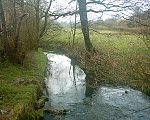Blackburn Meadows is an area of land just inside the Sheffield city border at Tinsley, England. It became the location of the main sewage treatment works for the city in 1884, and is now one of the largest treatment works in Britain. The treatment process was rudimentary, with sludge being removed to ponds and then to drying beds, after which it was used as manure or transferred by rail to a tip at Kilnhurst. The works progressively expanded to improve the quality of effluent discharged to the River Don and was a pioneer in the use of bio-aeration, following experiments by the works manager during the First World War. This process became known as the "Sheffield System", and was demonstrated to visitors from Great Britain and abroad. Despite these improvements, ammonia levels in the river below the works were high, and fish populations did not survive.
The works had its own internal standard gauge railway for over 100 years, which used three steam and three diesel locomotives over the course of its existence, until its replacement by road vehicles in the 1990s. During the 1926 general strike, the locomotives hauled trains over the main line, delivering wagons to Kilnhurst tip under a special dispensation. By the 1960s, the Sheffield sewer system was inadequate for the volume of effluent produced, and the Don Valley Interceptor Sewer was tunnelled beneath the city to the works, enabling 26 storm sewage overflows into the river to be shut down. Water quality was further improved by a new treatment process installed in 1992 to reduce ammonia levels, enabling fish stocks to be re-established in the lower River Don. Subsequent improvements have been made so that the works complies with the Waste Incineration Directive and the Freshwater Fish Directive. The works was inundated by flood water on 25 June 2007, when the Don burst its banks, but was recommissioned in just 18 days.
A power station was operational on the southern part of the site from 1921, supplying electricity to the steel works of the Lower Don Valley. Although it closed in October 1980, two of its cooling towers which were designed by L. G. Mouchel and Partners in 1937, remained until 2008, as demolition was difficult because of their proximity to Tinsley Viaduct, which carries the M1 motorway across the Don valley. Following extensive upgrading of the treatment works, to improve the quality of discharges to the river still further, the sludge beds became redundant, and have been turned into a nature reserve, providing habitat for migrating birds.










